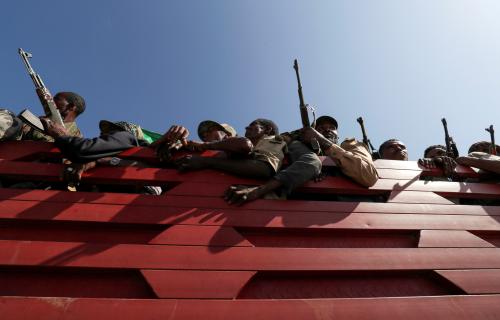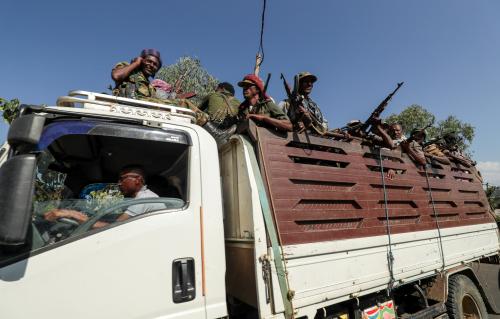Fighting continues in Ethiopia’s Tigray region
Fighting continued in Ethiopia’s Tigray region this week, in the continuation of a conflict that began earlier this month. On Sunday, November 15, the leader of the Tigray region, Debretsion Gebremichael, confirmed that his forces had fired rockets at the airport in Eritrean capital Asmara, a major escalation that internationalizes the war. In his announcement of the attack, Debretsion accused Eritrea of sending tanks and troops into Tigray in support of the Ethiopian government’s offensive. Eritrea’s government has denied involvement in the conflict. On Friday, November 20, Tigray also fired rockets at the capital of its neighboring region within Ethiopia, Amhara, raising fears that the conflict could spread to new areas of the country. Meanwhile, the Ethiopian government claimed that its forces were approaching the capital of the Tigray region, Mekelle, after winning a series of battles elsewhere in the region. The Ethiopian government has also continued to bombard Tigray with frequent air strikes occurring in Mekelle, including near a church and university.
In Sudan, aid agencies are now racing to provide humanitarian relief to the more than 30,000 refugees that have crossed the border from Ethiopia to flee the fighting in Tigray. The United Nations has announced plans to assist as many as 200,000 refugees over the next six months. Elsewhere, the international community has continued to call for the cessation of fighting and for negotiations to occur. U.S. President-elect Joe Biden has appealed for an end to the fighting and protection for civilians, and 17 U.S. senators have sent a letter to U.S. Secretary of State Mike Pompeo asking him to engage with Ethiopian Prime Minister Abiy Ahmed to press for a cease-fire and the protection of civilians. Officials in neighboring countries, including Uganda and Kenya, have also continued to call for dialogue to resolve the conflict.
For more on the conflict, see “Averting civil war in Ethiopia: It’s time to propose elements of a negotiated settlement” by Zach Vertin and tune in to next Tuesday’s event, Crisis in Ethiopia and its regional repercussions. For more on the implications of the Ethiopian crisis on Somalia, see Vanda Felbab-Brown’s piece on the subject.
3-decade ceasefire between Morocco and Western Sahara ends
Simmering, decades-old tensions between Morocco and Western Sahara boiled over late last week as Morocco launched a military incursion into the United Nations-patrolled buffer zone between the two countries. Citing “provocations” by Western Saharan pro-independence group Polisario Front—including the blocking of goods and people since October 21 along a key road connecting Mauritania and Morocco located in the buffer zone—Morocco moved military forces into that region. In response, on Saturday, November 13, the Polisario Front declared war on Morocco, commencing attacks on Moroccan targets. So far, no deaths have been reported, though the two sides have continued to trade gunfire.
In a letter to the United Nations, Brahim Ghali, the secretary general of the Polisario Front, stated that Morocco has now undermined “any chances of achieving a peaceful and lasting solution to the decolonization question of Western Sahara.” The king of Morocco also had strong words on the crisis, saying in an official statement that his country “remains firmly determined to react, with the greatest severity, and in self-defense, against any threat to its security.”
The history of the conflict is complex: Resistance to outside rule began when the region was a Spanish colony, a status that ended in 1975. That resistance continued under subsequent occupations by Morocco and (briefly) Mauritania. In 1984, Morocco left the African Union (AU; known then as the Organization for African Unity, or OAU) due to its recognition of Western Sahara, officially known as the Sahrawi Arab Democratic Republic (SADR), as a separate country. In 1991, the United Nations brokered a peace agreement that included a referendum for Sahrawis (the people of Western Sahara) to choose independence from or full integration with Morocco. This referendum, however, has still not yet occurred. Although Morocco rejoined the AU in 2017, it still refuses to recognize its southern neighbor’s independence and maintains it will accept only autonomy, not independence, as a solution. Notably, while 84 member states of the United Nations recognize a separate Western Sahara, the international body itself does not recognize either Moroccan nor SADR sovereignty over the region.
Africa’s debt crisis continues
African countries are facing a debt crisis as preexisting economic troubles have been worsened by the COVID-19-induced global economic downturn and the need for increased spending to combat the pandemic. Last weekend, G-20 finance ministers met to discuss debt relief for affected countries and agreed on a common approach for restructuring government debt. This approach will expand on the G-20 Debt Service Suspension Initiative, which was first adopted in April and temporarily suspends debt repayments until June 30, 2021—an extension, agreed upon in October, of the original January deadline. Major creditors, including China, are expected to adhere to the new approach, which provides guidelines for how debt deemed “unsustainable” can be reduced or rescheduled. International Monetary Fund Managing Director Kristalina Georgieva stated that this new approach should increase private sector participation in debt relief and provide a faster path toward the resolution of unsustainable debts.
On Thursday, November 19, China announced that it had extended debt relief to developing countries worth $2.1 billion total under the G-20 framework. This sum is the highest amount of debt relief, measured by amount deferred, given by any of the group’s members, though China also owns the highest amount of developing-country debt of any G-20 country, at $178 billion, or 63 percent of the total debt owed by developing countries to G-20 countries. Among African countries, approximately 40 percent of debt payments are owed to either official Chinese creditors or to the China Development Bank.
These steps toward debt relief come as Zambia defaulted on its debt after failing to pay $42.5 million owed at the expiration of a grace period for repayment last Friday. A eurobond creditor group that holds more than 40 percent of Zambia’s total eurobonds criticized Zambia’s government for its lack of direct discussion and for its plans to continue borrowing from non-concessional lenders over the next three years, stating that Zambia’s lack of engagement made providing near-term debt relief “impossible.”





Commentary
Africa in the news: Fighting in Ethiopia, end of cease-fire in Western Sahara, and debt relief updates
November 21, 2020